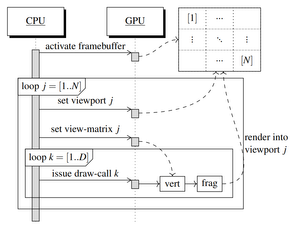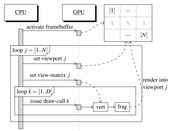Information
- Publication Type: Conference Paper
- Workgroup(s)/Project(s):
- Date: May 2020
- ISBN: 978-3-03868-107-6
- Organization: Eurographics
- Open Access: yes
- Location: online
- Lecturer: Johannes Unterguggenberger
- Event: EGPGV 2020
- Editor: Frey, Steffen and Huang, Jian and Sadlo, Filip
- DOI: 10.2312/pgv.20201071
- Call for Papers: Call for Paper
- Booktitle: Eurographics Symposium on Parallel Graphics and Visualization
- Conference date: 25. May 2020
- Pages: 13 – 23
- Keywords: Real-Time Rendering, Rasterization, Multi-View, OVR_multiview, Geometry Shader, Evaluation
Abstract
Efficient rendering of multiple views can be a critical performance factor for real-time rendering applications. Generating more than one view multiplies the amount of rendered geometry, which can cause a huge performance impact. Minimizing that impact has been a target of previous research and GPU manufacturers, who have started to equip devices with dedicated acceleration units. However, vendor-specific acceleration is not the only option to increase multi-view rendering (MVR) performance. Available graphics API features, shader stages and optimizations can be exploited for improved MVR performance, while generally offering more versatile pipeline configurations, including the preservation of custom tessellation and geometry shaders. In this paper, we present an exhaustive evaluation of MVR pipelines available on modern GPUs. We provide a detailed analysis of previous techniques, hardware-accelerated MVR and propose a novel method, leading to the creation of an MVR catalogue. Our analyses cover three distinct applications to help gain clarity on overall MVR performance characteristics. Our interpretation of the observed results provides a guideline for selecting the most appropriate one for various use cases on different GPU architectures.Additional Files and Images
Additional images and videos
Additional files
Weblinks
- https://diglib.eg.org/handle/10.2312/pgv20201071
- Entry in reposiTUm (TU Wien Publication Database)
- DOI: 10.2312/pgv.20201071
BibTeX
@inproceedings{unterguggenberger-2020-fmvr,
title = "Fast Multi-View Rendering for Real-Time Applications",
author = "Johannes Unterguggenberger and Bernhard Kerbl and Markus
Steinberger and Dieter Schmalstieg and Michael Wimmer",
year = "2020",
abstract = "Efficient rendering of multiple views can be a critical
performance factor for real-time rendering applications.
Generating more than one view multiplies the amount of
rendered geometry, which can cause a huge performance
impact. Minimizing that impact has been a target of previous
research and GPU manufacturers, who have started to equip
devices with dedicated acceleration units. However,
vendor-specific acceleration is not the only option to
increase multi-view rendering (MVR) performance. Available
graphics API features, shader stages and optimizations can
be exploited for improved MVR performance, while generally
offering more versatile pipeline configurations, including
the preservation of custom tessellation and geometry
shaders. In this paper, we present an exhaustive evaluation
of MVR pipelines available on modern GPUs. We provide a
detailed analysis of previous techniques,
hardware-accelerated MVR and propose a novel method, leading
to the creation of an MVR catalogue. Our analyses cover
three distinct applications to help gain clarity on overall
MVR performance characteristics. Our interpretation of the
observed results provides a guideline for selecting the most
appropriate one for various use cases on different GPU
architectures.",
month = may,
isbn = "978-3-03868-107-6",
organization = "Eurographics",
location = "online",
event = "EGPGV 2020",
editor = "Frey, Steffen and Huang, Jian and Sadlo, Filip",
doi = "10.2312/pgv.20201071",
booktitle = "Eurographics Symposium on Parallel Graphics and
Visualization",
pages = "13--23",
keywords = "Real-Time Rendering, Rasterization, Multi-View,
OVR_multiview, Geometry Shader, Evaluation",
URL = "https://www.cg.tuwien.ac.at/research/publications/2020/unterguggenberger-2020-fmvr/",
}


 paper
paper

